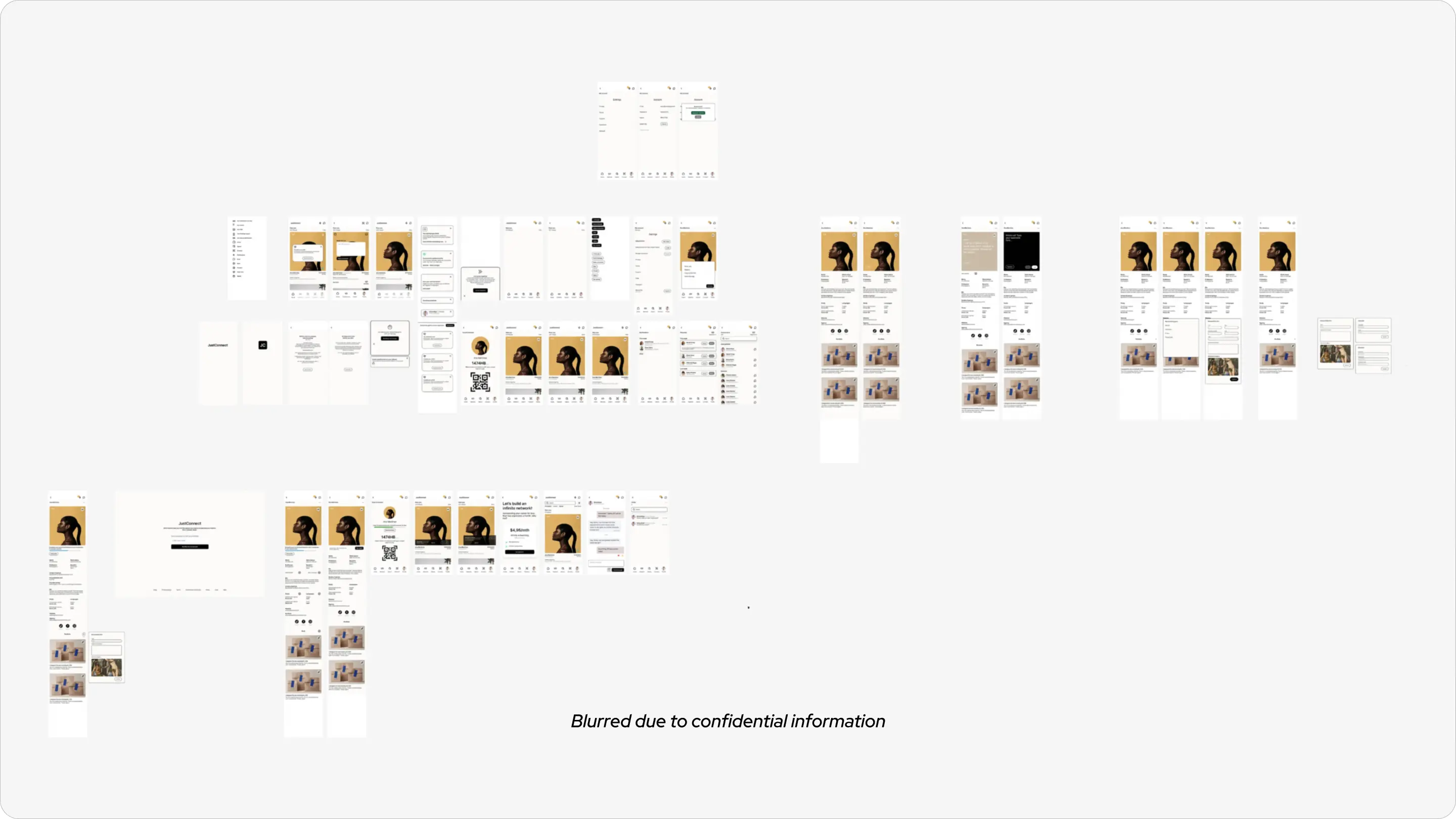JustConnect
Project Details
In this project, I led the entire process of bringing the JustConnect to life, from initial concept sketches to digital design and UI/UX wireframes. I carefully planned out the tooling and features, prioritizing a mobile-first approach and later expanding to desktop. I took on dual roles, handling both the branding and product design, ensuring a cohesive and user-friendly experience throughout. JustConnect aims to inspire users to build a strong network without the distractions of meaningless content, bots, and recruiters. Offering a tool for creatives to find and connect with like-minded individuals worldwide. We see JustConnect as a new way of working and aim to become the go-to platform for creatives. We are driven by people, not content. The attached imagery offers a glimpse into a few of the many steps undertaken throughout the process.
Client
Sector
Category
Year
JustConnect
Networking
Product Design and Creative Direction
2022
Background
JustConnect was envisioned as a networking platform tailored specifically for creatives, aiming to provide a space where artists, designers, writers, and other creative professionals could form meaningful professional connections without the distractions of irrelevant content, bots, and recruiters. I led the entire process of bringing JustConnect to life, from initial concept sketches to digital design and UI/UX wireframes. The objective of this case study is to provide a detailed overview of the steps taken in developing JustConnect and highlight the strategies and methodologies employed to achieve a cohesive and user-friendly experience.
Problem Statement
The core challenge was to develop a networking platform that prioritized meaningful connections over the noise and distractions typically found on other social networks. We needed a solution that could effectively filter out irrelevant content, bots, and recruiters to provide a focused and valuable user experience.
Key Constraints
The project had to be completed within a limited budget and under a tight timeline. Additionally, balancing the dual responsibilities of branding and product design presented a unique challenge, as it required a unified approach to both the visual and functional aspects of the platform.
Responsibilties
In this project, I was responsible for leading the design and development process from start to finish. This included creating the visual identity for JustConnect, encompassing logo design, color schemes, and overall branding elements. I also developed detailed UI/UX wireframes and digital designs, ensuring a seamless transition from concept to implementation.
Collaboration
Key team members and stakeholders I worked with included developers, marketing strategists, and potential users who provided valuable feedback during the testing phases. Collaboration with these stakeholders was crucial in aligning the design with the project’s goals and user needs.
The primary goal was to create a platform that fostered authentic professional connections among creatives while providing an intuitive and engaging user experience. Success metrics included user engagement, retention rates, and overall user satisfaction, aiming to position JustConnect as the leading networking tool for creatives.
Target Audience
The target audience for JustConnect consisted of creatives such as artists, designers, and writers who were seeking to connect with like-minded individuals for professional networking and collaboration.
User Personas
To better understand the needs of our users, we developed detailed user personas representing different segments of our target audience. These personas included profiles such as emerging artists looking for mentors, freelance designers seeking collaboration opportunities, and creatives aiming to network with other creatives.
Methods
The research phase involved a mix of surveys, interviews, and competitive analysis. Surveys and interviews with potential users provided insights into their networking challenges and preferences. Competitive analysis helped identify gaps in the market and opportunities for differentiation.
Insights
Key findings from the research indicated a strong demand for a platform that minimized distractions and focused on meaningful professional interactions. Users expressed frustration with existing networks that were cluttered with irrelevant content and automated connections, highlighting the need for a more streamlined and genuine networking experience.
Brainstorming
The ideation process began with brainstorming sessions to explore various design concepts and potential solutions. These sessions involved generating ideas for features and user flows that would align with the platform’s goal of fostering meaningful connections.
Strategy
The design strategy focused on creating a mobile-first platform with a clean and intuitive interface. This approach aimed to ensure that users could easily navigate the platform and connect with others without being overwhelmed by unnecessary content. The strategy also emphasised scalability, allowing the platform to expand to desktop while maintaining a consistent user experience.
Concepts
Initial sketches and low-fidelity wireframes were created to visualize the platform’s layout and core functionalities. These early designs helped map out the user journey and interface elements, providing a foundation for further development.
Feedback
Feedback from stakeholders and potential users was collected at this stage to identify areas for improvement. This feedback was instrumental in refining the sketches, addressing usability concerns, and ensuring that the design met user needs and expectations.
Methods
User testing involved conducting usability testing sessions and A/B testing to evaluate the effectiveness of different design elements. Users were observed as they interacted with the prototypes, and their feedback was gathered to identify any issues or areas for enhancement.
Results
Insights from user testing highlighted the need for adjustments in navigation flow and feature placement. These findings informed the final design iterations, ensuring that the platform provided an optimal user experience.
Design
High-fidelity prototypes were developed to showcase the final design and interactive features of the platform. These prototypes included detailed UI components and user flows, offering a realistic representation of the final product.
Iteration
Based on user feedback and testing results, several iterations were made to the prototypes. Changes were implemented to enhance usability, address any identified issues, and ensure that the design accurately reflected user preferences.
Outcomes
The JustConnect project concluded with the successful launch of a platform that met its design and user experience goals. The platform received positive feedback for its focus on meaningful connections and its user-friendly interface.
Impact
Post-launch metrics indicated strong user engagement and satisfaction, validating the design choices and strategic decisions made throughout the project. Users appreciated the distraction-free environment and the emphasis on genuine professional interactions.
Learnings
Reflecting on the project, it underscored the importance of a user-centered design approach and iterative development. Future considerations include expanding features to further enhance the platform’s ability to facilitate valuable professional connections and continuing to differentiate JustConnect in the competitive networking landscape.







